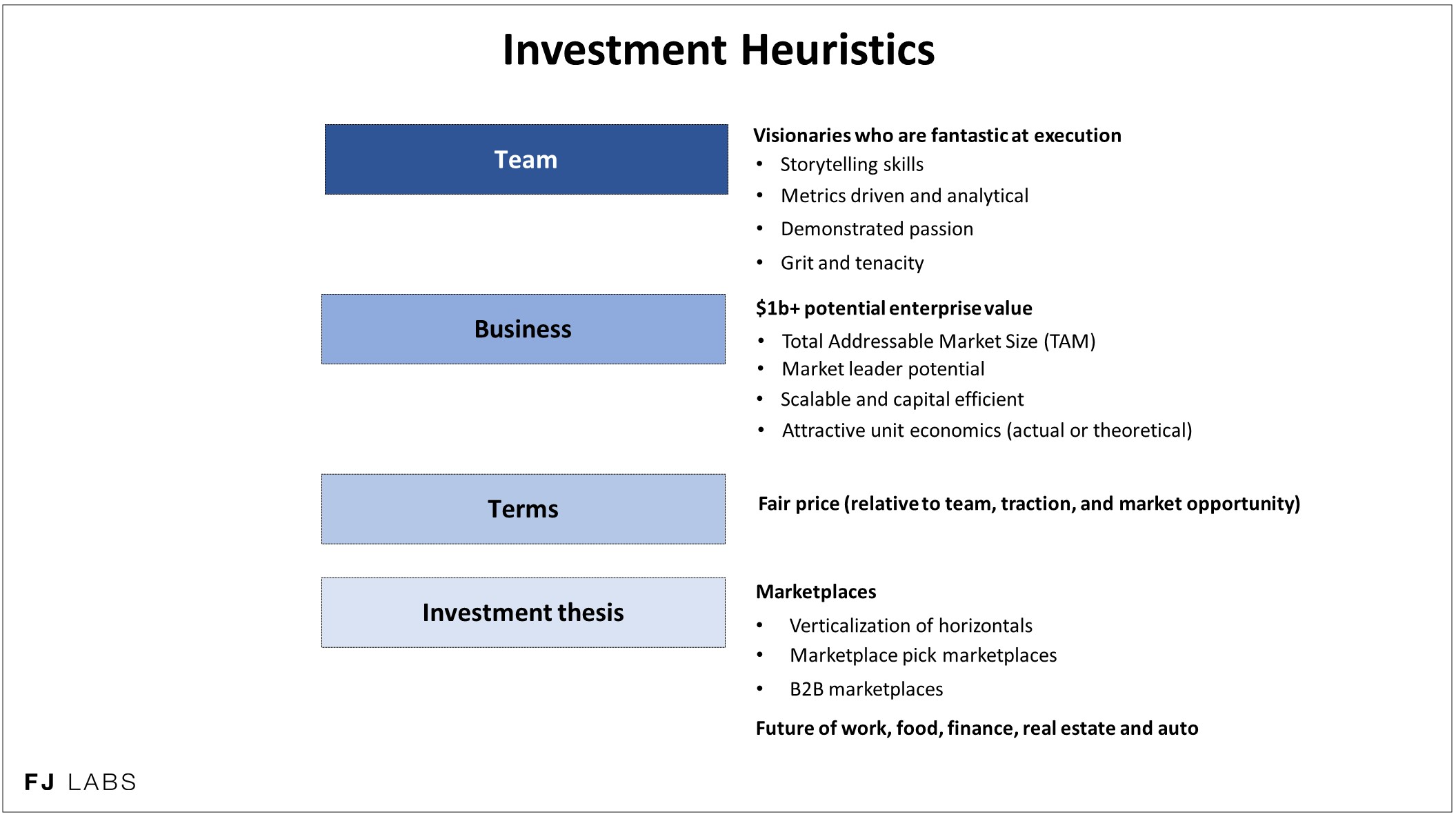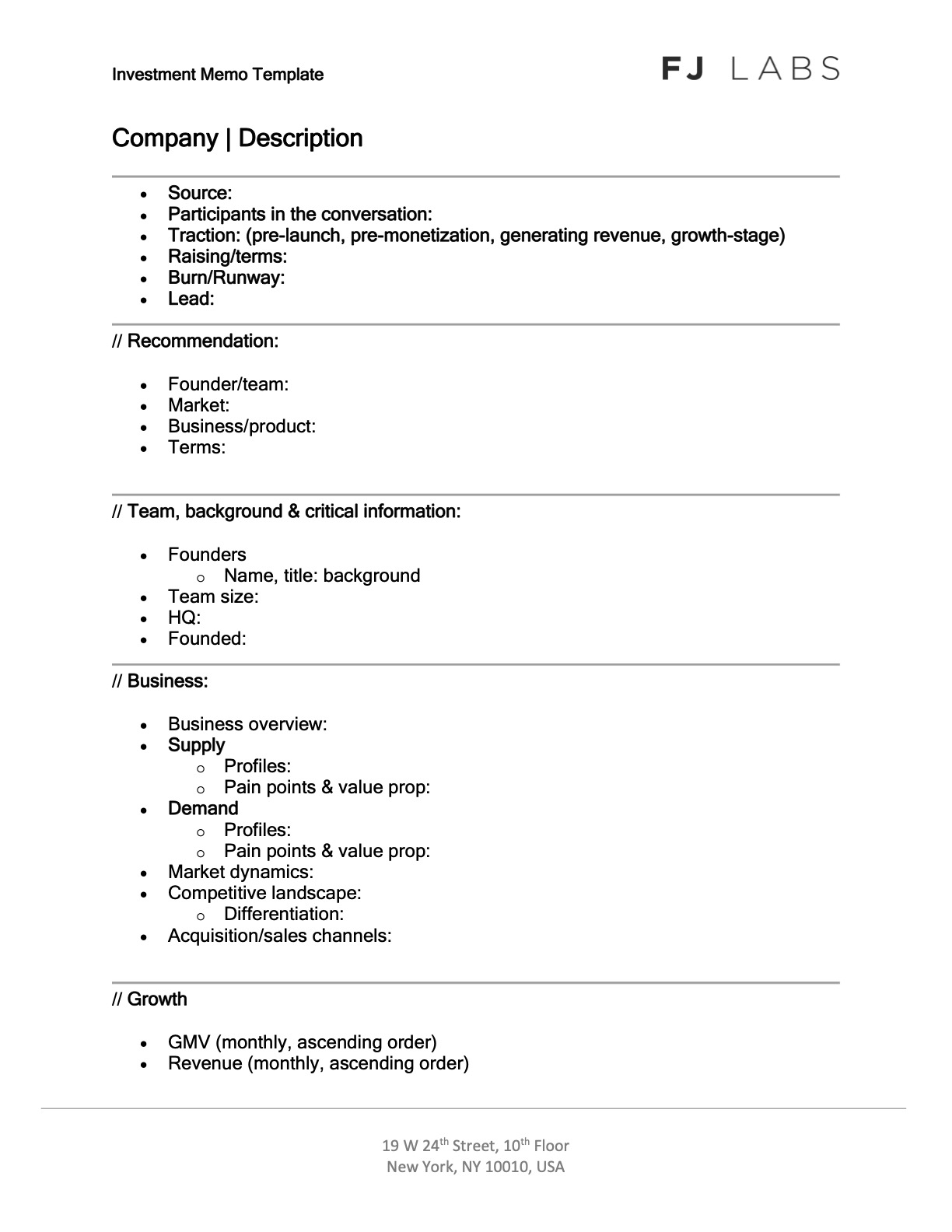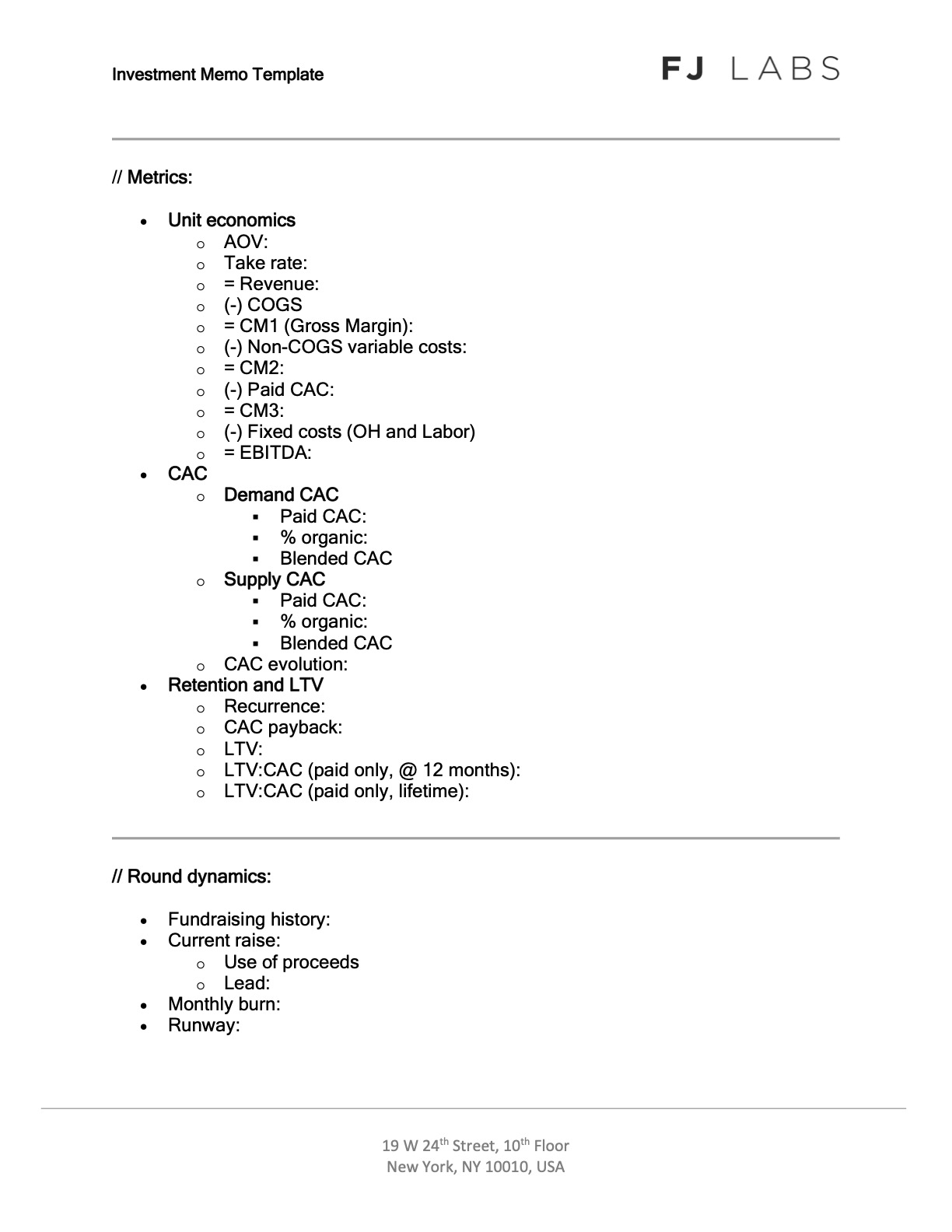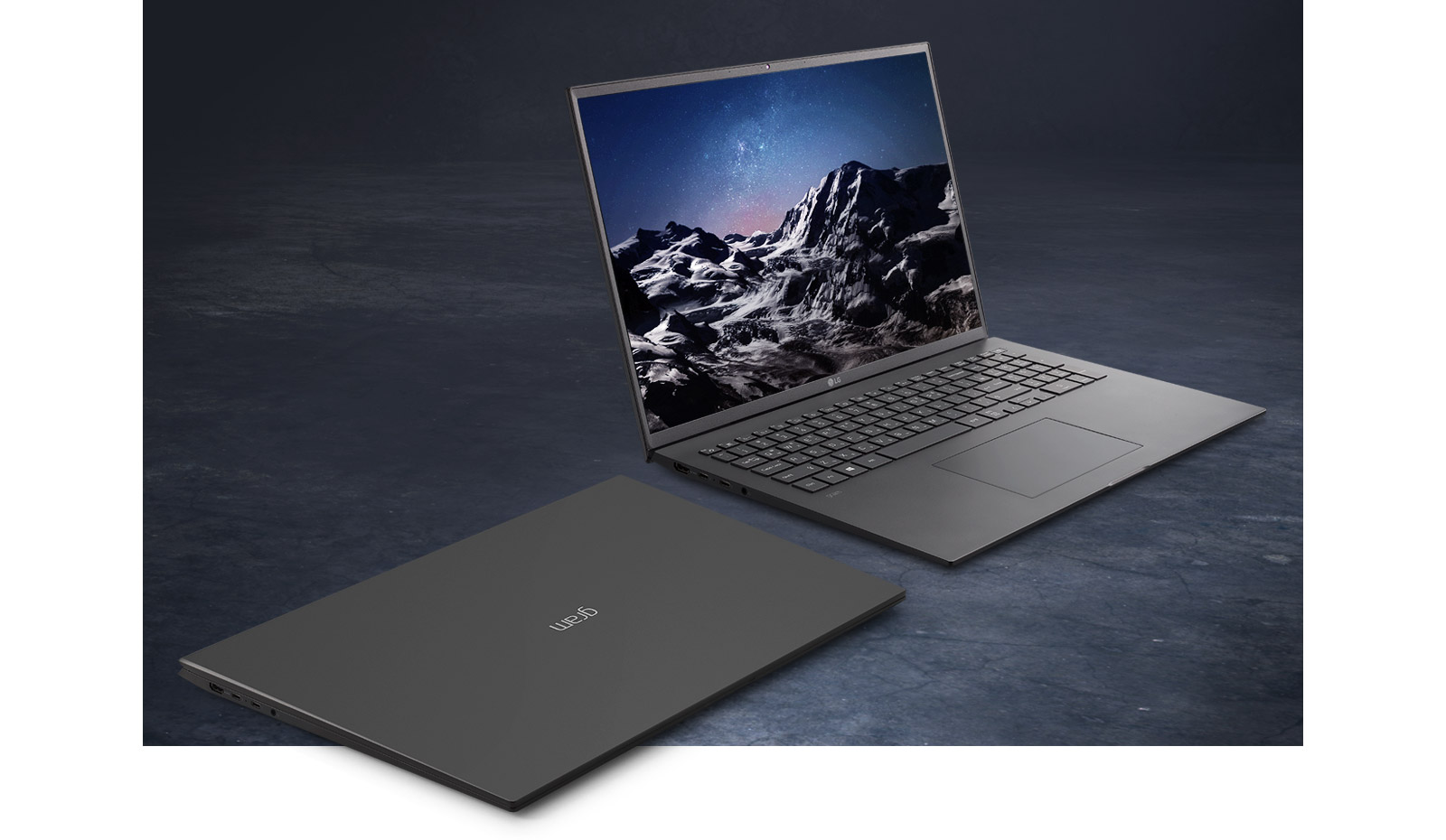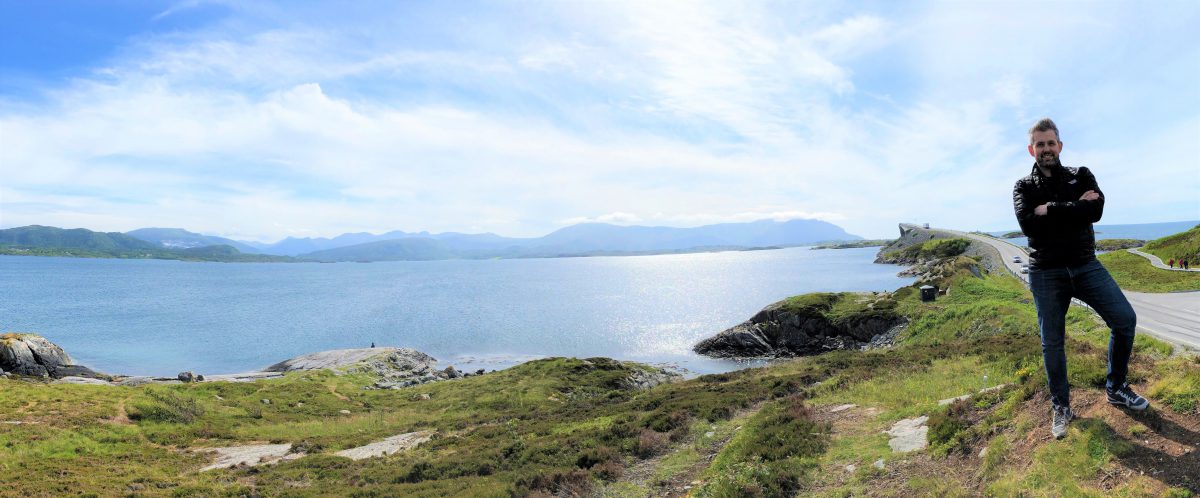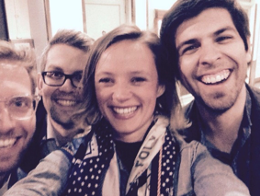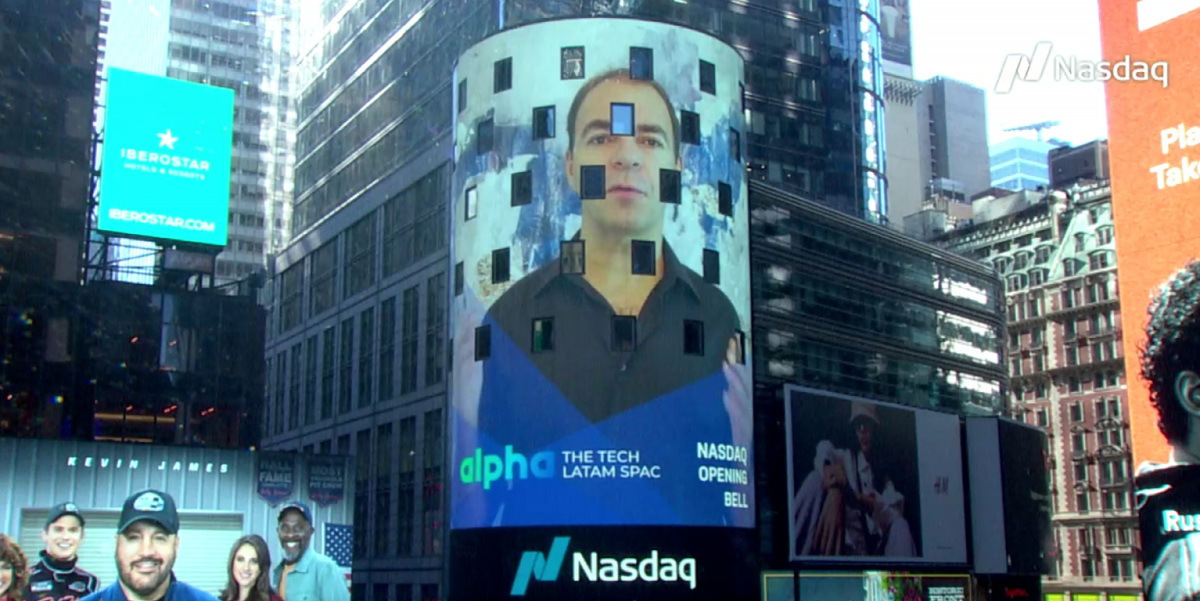我过去曾介绍过 FJ Labs 的投资策略,其中涵盖了我们希望投资的公司类型。 今天,我想具体谈谈我们如何评估初创企业。
我们采用四项标准:
- 我们喜欢这支球队吗?
- 我们喜欢这项业务吗?
- 交易条款是否公平?
- 企业是否符合我们对世界发展方向的判断?
接听我们第一个评估电话的投资团队成员会在一个小时内填写一份标准化的交易备忘录,根据这四个标准对企业进行评估。 然后,他或她再添加一条建议。 每周二,在两个小时的投资委员会会议上,我们都会回顾上周的交易建议。 然后,何塞或我与最有吸引力的企业进行第二次通话,深入探讨他们感兴趣的领域。
您可以在下面找到我们的交易备忘录。
在一两周内打完这两次 1 小时的电话后,我们就会决定是否投资。 我们还与初创企业分享我们的想法。 如果我们决定不投资,我们会告诉他们需要看到什么才能改变主意。
1.我们喜欢这支球队吗?
世界上每个风险投资家都会告诉你”我投资于非凡的人” 这是非常主观的。 这种潜在主观性的问题在于,它会导致认知偏差。
为了力求更加客观,我们评估了哪些创始人技能能让初创企业获得成功。 根据我们的分析,我们需要有远见、执行力强的创始人。 多年来,我们注意到,讲故事的技能和分析技能是这些技能的良好替代品。 讲故事的能力是关键,因为一个人如果能编织一个引人入胜的故事,就更容易吸引资本,能以更高的估值筹集资金,建立一支拥有更优秀人才的团队,签订非凡的业务发展协议以加快公司发展,并获得大量免费媒体报道。
想象一下,你来向 FJ 实验室推销,然后告诉我们:”我做了深入的市场分析。市场很大,很有吸引力。现有公司发展缓慢,而我的方法与众不同,效果更好”。这是事实,似乎很有说服力,但这不是一个故事。故事听起来更像下面这样:”这是我一生都要面对的问题。我讨厌当前的用户体验。我讨厌当前的用户体验,它让我感到厌烦,以至于我要用我的余生来解决这个问题。因为我经历了太多,所以我很清楚解决方案是什么”。这种激情,以及你的故事与你正在创建的公司之间的交集,非常引人注目。这不是一个具体的例子,但它能让你了解我们在寻找什么。
如果你只有非凡的讲故事能力,那是远远不够的。 也许你可以建立一家大型企业,但它可能经营不善或资本效率不高。 你可能会创建一家像 Fab.com 这样的公司,获得数亿美元的收入,但却永远无法实现单位经济效益,公司也无法赚钱。 又或者,你建立了一家像 Theranos 这样的公司,在那里你推销一个人人都愿意相信但最终并不真实的奇妙故事。
因此,我们寻找的第二位创始人/首席执行官还必须以指标为导向,善于分析,并知道如何执行自己的愿景。 他们确实需要了解自己所从事的业务。 他们需要能够阐明其单位经济效益。 即使他们的业务尚未启动,他们也需要了解基于行业平均水平和着陆页测试的理论单位经济效益。 然而,仅有这些技能也是不够的。 如果缺乏讲故事的技能,这些创始人只能创建小型、盈利的企业,而无法创建行业领先的企业。
我们也会考察学生的激情,但这通常是在评估讲故事的技巧时体现出来的。 同样,我们还需要勇气和坚韧。 也许你经历了艰辛才走到今天的位置,但这并不重要。 在西方,我们有足够的特权,许多人并没有真正面对过逆境。 你可以上好学校,取得好成绩,找到好工作,一生都不会真正失败。 然而,我们真正想要了解的是,你将如何应对前进道路上面临的无数挑战,尤其是作为初次创业者。
我们的做法是,对向我们投稿的创始人提出智力挑战。 我们要挑战他们的假设、他们的预期和原因。 我们测试他们对此的反应。 如果他们在我们对其业务的质疑压力下崩溃,那么很显然,他们将在作为创业者所面临的无数失败的更大压力下崩溃。 最终,您对我们挑战的回应还体现在您讲故事和分析的能力上。
总之,我们非常希望支持那些既有远见卓识又有出色执行力的稀有创始人。
2.我们喜欢这家企业吗?
值得一提的是,对于某些风险投资公司来说,拥有一支出色的团队就足够了。 他们的理由是,非凡的团队会把业务搞清楚,即使他们一开始所从事的业务并不引人注目,或者没有具有吸引力的单位经济效益的业务模式。
FJ 实验室的情况并非如此。 美国每年约有 5000 家初创企业获得 50 万美元或以上的融资。 这些初创公司的 5 年存活率平均为 7%,而那些没有商业模式的公司的存活率要低得多。 相比之下,在我们退出的 150 多笔交易中,有 50% 赚到了钱,这是因为我们遵守了纪律,而对业务的喜爱在其中起了很大作用。
有几项标准使企业引人注目。 总可寻址市场(TAM)是否足够大? 如果不能,你能让市场发展到足以支撑一个十亿美元的公司吗? 在市场环境中,要建立一个价值连城的大型企业,还有很多辅助工作要做。 您有能力成为市场领导者吗? 这可以扩展吗? 成功还意味着不会被 “脱媒”,这意味着供需双方有合理的分工。 但在我看来,这些因素都属于 “是否有机会”是否有机会在这里建立一家价值十亿美元的公司?“
除此以外,我们在评估企业时最关心的一点是:它的单位经济效益是否具有吸引力?如果初创企业处于启动前阶段,那么这个问题就适用于你的理论单位经济效益。 如果是启动后的初创企业,我希望能讨论实际的单位经济效益。 请注意,为了简明扼要,我假定本文的读者知道我所说的单位经济学是什么意思。 关于 FJ 实验室如何看待单位经济效益,我将很快另开一篇文章。
从我们的角度来看,良好的单位经济效益是指初创企业在运营的前 6 个月内,能够在净贡献利润率的基础上收回其客户获取成本(CAC)。 我们还期待这家初创企业在 18 个月内将其 CAC 提高到 3 倍。 在我们接触过的优秀企业中,由于负流失率的存在,他们根本不知道长期价值(LTV)与 CAC 的比率(LTV:CAC)是多少。 即使他们失去了一些客户,但剩下的客户会继续购买更多的产品,LTV:CAC 可能达到 10:1,甚至 20:1。
请注意,这条规则也有例外。 对于粘性极强的 SaaS 企业来说,客户流失率为负数,客户生命周期基本上是无止境的,即使需要 12-18 个月才能收回 CAC 也没关系。
对于创业前的企业,我们希望创始人已经想好了单位经济效益应该是多少。 他们应该了解行业的平均订单价值,并期望与之保持一致。 他们还应该对基本的销售成本(COGS)有很强的把握,从而对每笔订单的利润率有很好的认识。 还应了解行业的平均复发率。
未知的部分是客户获取成本。 不过,您可以进行测试。 在建立功能网站之前,您就可以创建精美的登陆页面来描述概念。 然后,您可以花一些钱进行营销,并对每次点击的成本、每次注册的成本以及注册后的潜在购买量做出合理的假设。 您还可以使用行业的平均值,即访问该类别网站的访客中有多大比例会购买东西。
请注意,我还希望您评估客户获取渠道的密度。 您是否可以每月花费 5 万、10 万、50 万或更多,但仍能获得有吸引力的单位经济效益? 如果不是这样,你手上的就是一个有趣的小企业,但不是一个可扩展的风险投资企业。
如果您的产品已经上市,我们希望您能向我们介绍一下您的实际单位经济效益。 他们可能还达不到我们期望的 18 个月净贡献利润率与 CAC 比值 3:1 的要求,因为您的 CAC 过高,或者您的每笔订单贡献利润率或复发率过低。 不过,如果你能告诉我们为什么你的单位经济学会达到一定的规模,而不需要宇宙中所有的星星都齐心协力,我们可以忽略这些。
例如,您可能从事送餐业务。现在,你给送餐员的工资是每小时 15 美元,而他们每小时只能送一次餐。结果,你的经济效益被压低了。但如果你告诉我:”听着,现在我每月的 GMV(即商品销售总额)是 10 万美元。一旦我在相同地区的月销售额达到 30 万美元,保守估计,在未来 12 个月内,司机每小时将送货 3 次。每次送货的成本将降到 5 美元,在这种规模下,单位经济效益就会发挥作用。如果你能让我相信你有一个合理的计划,在未来 12 个月内将这些地区的配送量提高两倍,那么这个故事是可信的,也是令人信服的。
通过扩大规模提高利润率的例子不胜枚举,因为你可以利用供应商的优势,在营销和客户参与方面做得更好。 最终,即使你的单位经济效益尚未达到目标,你也需要一个令人信服的故事,说明你将如何实现规模化。
在本节的最后,虽然我们在评估一项业务的吸引力时会考虑很多因素,但归根结底都是:我们能否建立一个单位经济效益极具吸引力的十亿美元级企业?
3.交易条款是否公平?
在一轮融资中,有许多术语:
- 我们能够以什么样的估值进行投资?
- 公司正在筹集多少资金?
- 是首选吗?
- 是可转换票据还是实际股权投资?
- 我们有拖带权、跟随权、按比例权和优先权吗?
我们所做的所有投资都至少有 1 倍的清算优先权,因为我们不希望出现投资者亏损而创始人赚钱的情况。 换句话说,我们绝不会投资普通股。 除此之外,我将重点讨论的术语是估值。 我们关心估值。 这并不是说我们的投资估值很低。 我不认为互联网初创企业投资存在估值过低的问题。 不过,考虑到牵引力、机遇和团队,我们希望以合理的估值进行投资。
在我们关注的市场领域,对不同阶段的估值和牵引力有一套合理的预期。 我将举几个例子,但请注意,范围涵盖了中位数。 但也有很多例外,尤其是高端产品。 换言之,标准偏差相当高。 第二次成功的创始人可以以更高的估值进行融资。 成长速度比一般公司快得多的公司往往可以 “跳过一个阶段”,把 A 轮融资做成 B 轮融资,或者把 B 轮融资做成 C 轮融资。
除了在合适的阶段筹集到合适的资金外,风险投资公司通常还按阶段划分专业。 您需要在合适的阶段与合适的风险投资人对话。 此外,还有一个内在的增长预期,即您需要在 18 个月左右的时间内从一个阶段过渡到另一个阶段。
在下面的例子中,我要说的是 10%到 20%的市场。 对于预选赛来说,你基本上处于启动阶段,没有销售额或销售额微乎其微。 如今,大多数种子期前初创企业的融资额都在 750k-1 百万美元之间,融资前估值为 3-5 百万美元。
在种子期,您每月的 GMV 为 10 到 20 万美元,按 15%计算,您的净收入为 3 万美元。 您的月净收入通常在 1 万至 5 万美元之间。 你通常会以 6-1200 万美元的预付款筹集到 240 万美元。 从种子轮到 A 轮,你们每月的 GMV 为 15 万,我们预计你们将从每月 15 万增长到大约 65 万,滞后期为 18 个月。 换句话说,该阶段的预期增长水平是每年 300%,或每月 15%的增长水平。
而你的 A 轮融资,一旦每月 GMV 达到 50 万至 100 万美元,就能以 1,500 万至 3,000 万美元的投前估值融资 500 万至 1,000 万美元。 平均约为 700 万美元,前期 1 800 万美元,后期 2 500 万美元。 这样,我们预计 18 个月后,您每月的 GMV 将达到 200-400 万美元。 然后,您可以以 4,000 万至 8,000 万美元的预付资金,筹集 1,500 万至 2,500 万美元的 B 轮融资。 我将我们的内部市场矩阵作为参考。
多年来,这一直是我们默认的内部框架,但仅限于承购率为 10-20% 的市场,而这曾是我们的主要业务。 不过,现在我们主要投资于 B2B 市场,这些市场的成交率通常只有 1%-5%。 该框架也不适用于 SaaS 企业和电子商务企业。
此外,你应该向谁筹款以及对筹款收益的预期也不够明确。 投资人和风险投资人通常按阶段划分,您需要在正确的阶段与正确的风险投资人交谈。 因此,我重新设计了矩阵,使其更加清晰,并涵盖大多数情况。
为了解决每个阶段的预期牵引力问题,我将参考指标从商品销售总额(GMV)改为净收入。 这使我们能够对不同业务模式的牵引力进行比较,尽管仍存在一些差异,如大多数 SAAS 业务的利润率超过 90%,而大多数市场的利润率为 60-70%,电子商务的利润率也各不相同。
虽然有明确的行业平均值,但有些风险投资人对估值并不敏感,因为在他们看来,唯一重要的是参与能带来所有回报的最佳交易。 Venture 遵循幂律分布,而不是正态高斯分布。 每十年就有两家超级独角兽–在美国生态系统中诞生的价值超过 1000 亿美元的初创企业。 它们占所有风险投资回报的 40%。 除此之外,每十年还有 20 家脱胎换骨的公司(价值超过 100 亿美元)诞生,占所有风险投资回报的 40%。 每十年诞生的 100 多家独角兽企业占了剩余回报的大部分。
大多数风险投资公司都在玩 “强力球 “游戏。 他们想成为超级独角兽彩票的赢家,并愿意付出一切代价。 他们在大多数投资上亏损也没关系。 FJ 实验室不这样运作。 我们希望我们投资的所有初创企业都是可行的,这也是我们关注其单位经济效益和投资估值的原因。
正因为如此,我们投资的 50% 以上的初创企业都赚到了钱。 我们经常以 500 万美元的投前估值进行投资,然后以 3000 万美元的估值退出,因为公司业绩还不错,但规模没有达到最初的预期。 如果我们只是在寻找独角兽,并愿意为这些初创企业支付过高的费用,我们就会在类似的投资上亏损。
请注意,我们推动 “公平估值 “不仅仅是出于自身利益。 我们真的认为,创始人以过高的价格筹集过多的资金是对自己的一种伤害。 如果事与愿违,公司没有按照估值增长,那么公司就可能会倒闭,因为很少有人愿意经历一轮又一轮的下跌。 考虑到大多数情况下都有反稀释条款,这些都会对心理造成创伤,并对上限表产生负面影响。 此外,筹集到太多资金的人往往会把资金花在刀刃上,而无法达到应有的资本效率。
当然,也有一些反面例子,比如 Uber 等公司不断融资,在牵引力之前成功上市,但一路上也有很多尸体,包括我们自己的 Beepi。
4.企业是否符合我们关于世界走向的论断?
我们专注于市场平台,并对市场平台的未来有具体的论述。 目前,我们特别关注的是
- 横向(多类别)平台垂直化
- 市场挑选市场
- B2B 市场
凭借在众多行业中参与过的众多交易,再加上对历史和趋势的研究,我们对这些行业的未来有着非常明确的看法。 我们有关于未来食品、未来工作、金融、贷款、房地产和汽车等方面的具体论文。
我们投资的大多数企业都同时触及上述多个主题。 我将很快撰写一篇详细的博文,介绍我们当前的投资理念。
结论
当我们在两个小时的通话中对初创企业进行评估时,我们会从四个方面对其进行评估:团队、业务、交易条款以及与我们的论点是否一致。 我们希望所有四项标准都能同时得到满足:出色的创始人,拥有伟大的企业,以公平的条件筹集资金,符合我们的论点。 如果你是一位出色的创始人,但觉得估值过高或业务不引人注目,我们将不予投资。 同样,如果想法很好、条件很好、论文很充分,但我们觉得团队很平庸,我们也不会投资。
在这四个变量中,我们对论题有一定的灵活性。 虽然我们主要是市场投资者,但我们也投资那些支持市场但本身可能不是市场的初创企业。 作为例外,我们投资于那些超出范围,但我们认为非常有吸引力的想法。 我们也支持那些过去曾为我们取得成功的创始人,即使他们的新创公司不是一个市场。 因此,我们最终投资了电动 VTOL 飞机初创公司Archer。 我们为 Brett Adcock 和 Adam Goldstein 的劳动力市场初创公司 Vettery 提供了支持,该公司已出售给 Adecco。 尽管我们在电动自动飞行器领域缺乏专业知识,但我们很高兴能支持他们的新公司。
要求我们的四项投资标准必须共同满足,这与硅谷许多风险投资公司决定投资的方式大相径庭。 他们不惜一切代价支持优秀的球队,而不考虑当前的单位经济效益,并期待他们能想出办法。 不过,如果分析一下风险投资回报的分布情况,我们的做法似乎是有道理的。 65% 的投资回合无法获得 1 倍的资本回报,只有 4% 的投资回报超过 10 倍资本回报。 目前,我们 218 个退出项目(包括所有失败项目)的实现内部收益率为 61%,一半以上的退出投资项目都赚到了钱。
请注意,我们选择这种方法的部分原因是,过去大多数独角兽和脱壳企业都出自硅谷。 我选择在纽约生活是出于个人原因:我喜欢这里的知识、艺术和社交氛围。 此外,从纽约前往我家所在的尼斯也比旧金山方便得多,与欧洲的时差也更容易控制。 换句话说,我选择了纽约,因为我知道这将使我在经济上的成功大大低于我住在硅谷的成功,因为我预计我看不到也无法投资于最优秀的公司。 我对这一选择很满意,因为我优化自己的生活,是为了获得幸福和成就感,而不是经济回报。
随着开源、AWS 和低代码/无代码革命的出现,我们看到了初创企业创建的民主化。 在比以往任何时候都更多的地域创建和扩大公司规模。 我们看到,像 Shopify 这样的超级独角兽企业正在硅谷之外(这里指的是多伦多)崛起。 随着越来越多的公司以分布式方式建立,COVID 只会加速这一趋势。
因此,我甚至预计,随着时间的推移,我们的相对劣势将逐渐消失,我们将能够从早期阶段就投资更多的独角兽企业,尤其是我们在市场平台上不断提升的品牌让我们甚至能够投资硅谷最好的交易。 迄今为止,我们已经投资了 25 家成为独角兽的公司,还有 25 家已经是独角兽的公司,但自我们投资以来,其估值增加了超过 10 亿美元。 尽管情况有所改善,但我们仍将严守纪律,继续采用我们的四项遴选标准。
这就是:我们如何在一小时内评估初创企业! 既然你已经了解了我们是如何决定是否对你的初创企业进行投资的,那么你就应该相应地改进你的推介。
祝你好运


